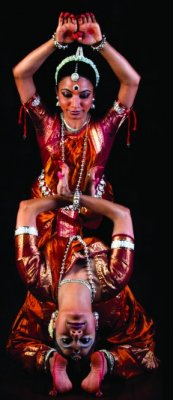
|   |

|   |
Nrityagram’s Samhara: A meeting of styles - Megana Prasad e-mail: megan.prasad@gmail.com March 26, 2012 As a serene raag Madhuvanti emanates from the flute, the house lights dim and the curtains part to reveal the familiar silhouettes of the Nrityagram dance ensemble. Surupa Sen, Bijayini Satpathy, and Pavithra Reddy have returned once more to the United States from the little dance village of Nrityagram, outside of Bangalore, that they call home. This time, however, they have a special treat. Their latest project ‘Samhara’ (Sanskrit for collection or skill), which premiered this week at the Joyce Theater in Manhattan, is their very first collaborative work and teams them up with the Chitrasena Dance Company from Sri Lanka, practitioners of the Kandyan style of dance. As is tradition, the Nrityagram dancers begin the evening by invoking the Gods. They seek the blessings of Goddess Parvati with all her strength, her compassion, and her grace. They remind us of the sinuous movements of Odissi - the characteristic S-shaped tribhanga stance, the gentle torso movements, and the circular contours that lend the style its grace.  And then enter the two beautiful and talented Kandyan dancers Thaji Dias, granddaughter of Chitrasena and Vajira, founders of the Chitrasena Dance Company, and Mithilani Munasingha, who represent the company in ‘Samhara.’ The differences between Kandyan dance and Odissi are at once evident. The Kandyan dancers are much lighter on their feet and spend less time in contact with the ground than do the Odissi dancers. Their stance is broader and less feminine. Their style is a lot more athletic than Odissi. Although Sen, the artistic director of Nrityagram and choreographer of Samhara, discreetly leaves the stage to lend her voice to the “bols” that define the dancers’ rhythm in this piece, her brilliance shines through on stage. To an eye unaccustomed to the Kandyan style, Sen does a fantastic job of drawing parallels between the seemingly different styles of Kandyan dance and Odissi. She highlights the similarities in stance - the Odissi ‘chowka’ and the Kandyan ‘mandala’ like stance. She underscores the torso movements, thought to be the realm of Odissi, that are also practiced in the Kandyan style, albeit differently from the lateral movement of the torso in Odissi. Sen also emphasizes the similarities and differences between the moods of the two styles. Where Odissi is naughty and sensuous, Kandyan dance is playful and energetic. As the dancers portray the five elements of nature - earth, water, fire, air, and ether – their vibrancy and dynamism is captivating, and the energy of their interactions on stage is almost palpable, making one want to reach out and grab some part of it, so as to never cease experiencing it. The program then shifts focus once again to Odissi, with Sen and Satpathy skillfully demonstrating the rich vocabulary of Odissi, both in terms of hand gestures and facial expressions, as they together enact a poem about the majesty, power and anger of Shiva. Satpathy, the director of the Odissi gurukul at Nrityagram, awes the audience with her control and poise as she describes the Tandava of Shiva. She executes challenging and statuesque poses with what seems like little effort. Her dedication to preserving the form of Odissi is evident. Sen, with her ensuing solo on the regret of Lord Krishna at hurting the feelings of Radha with his philandering ways, demonstrates her mastery over abhinaya, the story telling and interpretive aspect of Odissi, and emphasizes the intellectual aspect of Odissi. Lynne Fernandez, the technical director and executive producer of the show, is an expert at using lighting to accentuate the mood of the dance, drawing attention to the dancers in an almost subliminal way. Yet, I am impatient for the concluding piece of the show, another meeting of the Kandyan and Odissi dancers on stage. The energy from the start of the show takes over once again. I don’t know where to look and on whom to focus as the dancers cover the entire stage with such agility and speed. They converse with each other through the vocabularies of their styles; a vocabulary that I must concede is much richer in Odissi. As the tempo and fortitude of the music calms, indicating the end of the show, I long for but another few minutes of the sheer bliss that marked the show. Megana Prasad is a student of Odissi, learning from Dr. Chitra Krishnamurti in Rockville, MD. |